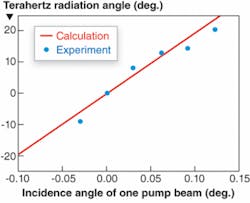OPTICAL COMMUNICATIONS: Difference-frequency generation steers terahertz beams quickly

Two researchers at RIKEN (Sendai, Japan) have come up with a way of quickly and easily steering a beam of terahertz radiation over a wide angular range (potentially ±90°).1 The technique is important for the nascent field of terahertz communications.
Wireless communication is everywhere these days, and is used at increasingly high data rates. One novel way to transmit information wirelessly over short distances is to use terahertz radiation instead of radio waves.2 While a clear path would be required, the jump in communication speed would be large—a consequence of the much shorter wavelength of terahertz radiation.
Although broadcasting data via terahertz radiation omnidirectionally is one possible way to reach a mobile user, it has two crippling disadvantages. First, because terahertz radiation is attenuated by the atmosphere, huge amounts of power would be required for omnidirectionality; and second, terahertz radiation can bounce off objects and interfere with itself, reducing the signal.
Both these problems are solved if a narrow, steerable terahertz beam is used instead. Communication from a base station to a mobile unit would then require only modest power to overcome any beam attenuation, and also would not interfere with itself.
Phased-array principle
The steerable terahertz beam developed by Ken-ichiro Maki and Chiko Otani operates on the same principle as does a phased-array microwave antenna, in which individual antenna elements, each with its own phase shifter, are lined up in an array; applying phase shifts to each element in linear proportion steers the beam. However, the RIKEN approach does not require an array of antennas.
Instead, a specially modified ultrafast-laser pump beam is split into two equal parts, reoverlapped with a spatial shift between them, and bounced at an angle off a nonlinear optical device (a strip-line photoconductive antenna); the resulting terahertz beam can be shifted through large angles through a very small angular change of one of the ultrafast-laser beams. That small angular change produces the same linearly varying phase shift as does a phased-array antenna.
But how can one ultrafast-laser beam, split in two and recombined, create a terahertz beam? It happens because the modification to the ultrafast pump beam consists of “spatially dispersing” it, or bouncing it off a grating to create a diffracted fan of light that is then collimated by a positive lens. Because the fan of light varies in frequency across the fan, the frequency of the collimated pump beam varies from one side of the beam to the other. When the beam is split, then recombined with the proper lateral spatial shift between the two parts and caused to strike the photoconductive antenna, the result is terahertz difference-frequency generation between the two beams that is the same at every point where the two pump beams overlap—and thus a terahertz beam is emitted from the nonlinear optical device.
Both steering and tuning
The terahertz beam is steered through a large angle by steering one of the ultrafast beams through a much smaller angle. For example, changing the terahertz beam angle by about 15° involves changing the incident angle of one of the ultrafast pump beams by a mere 0.10° (the exact ratio of steering angles was 187). Although the ultrafast-beam angle was changed mechanically in the experiment, the required angular range is small enough that electro-optic deflectors (maximum range of less than 1°) or acousto-optic deflectors (maximum range of a few degrees) could be used in future setups, entirely eliminating mechanics. With proper design, the system could have a terahertz-beam steering range of close to ±90°.
In addition, the frequency of the emitted terahertz beam can be tuned at will (separately from changing its angle) simply by changing the lateral shift between the two ultrafast-laser pump beams, thus increasing or decreasing the frequency difference between them. The researchers were able to tune the frequency of the output beam between 0.3 to 1.7 THz.
In use for wireless communications, the terahertz beam would track the mobile terminal by using the level of received power at the terminal for feedback control, says Ken-ichiro Maki. Along with multiple beams produced by spatial light modulation, the concept is similar to “smart antennas” developed for wireless communications in the microwave range, Maki notes. Other possible uses include a rapidly tunable terahertz spectroscopic imaging system.
REFERENCES
1. K. Maki and C. Otani, Optics Express 16(14) 10158 (July 7, 2008).
2. M.J. Fitch and R. Osiander, Johns Hopkins APL Technical Digest 25, 348 (2004).
About the Author
John Wallace
Senior Technical Editor (1998-2022)
John Wallace was with Laser Focus World for nearly 25 years, retiring in late June 2022. He obtained a bachelor's degree in mechanical engineering and physics at Rutgers University and a master's in optical engineering at the University of Rochester. Before becoming an editor, John worked as an engineer at RCA, Exxon, Eastman Kodak, and GCA Corporation.
